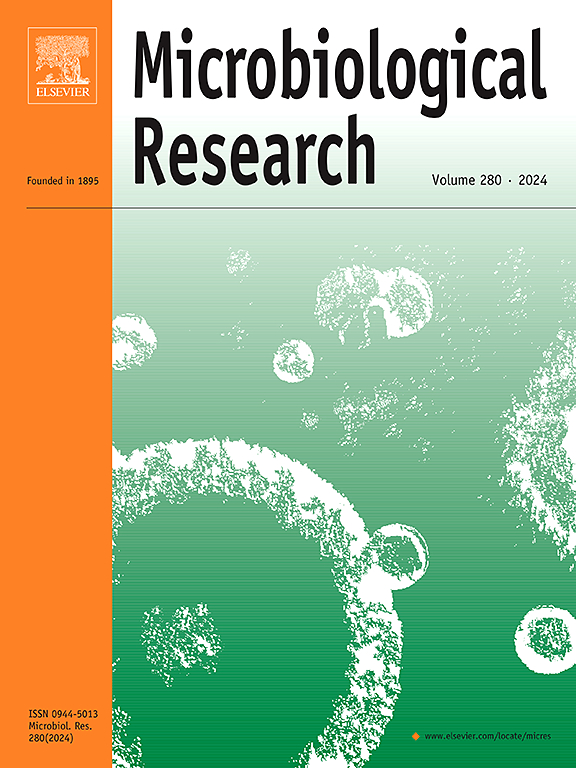探索 pehR 在 Ralstonia solanacearum 致病机理中的多方面作用:酶活性、运动性和生物膜形成
IF 6.1
1区 生物学
Q1 MICROBIOLOGY
引用次数: 0
摘要
PehR 是 Ralstonia solanacearum 中发现的各种反应调节因子中的一种转录调节因子,这种细菌在全球 450 多种植物中引起致命的枯萎病,其中包括番茄、辣椒和青江菜等具有重要经济价值的作物。PehR 可调节聚半乳糖醛酸酶的产生,这是一种能降解植物细胞壁的胞外酶,在细菌枯萎病中发挥着重要作用。尽管 PehR 意义重大,但其在 R. solanacearum 中的确切功能和调控机制仍有待深入研究。本研究的目标是通过确定 PehR 调控的基因和途径,更好地了解 PehR 在 R. solanacearum 致病性中的作用。通过破坏 pehR 基因,我们创建了 R. solanacearum F1C1 的 ΔpehR 突变体。转录组分析显示,与野生型 F1C1 菌株相比,ΔpehR 突变体中有 667 个差异表达基因(DEGs),其中 320 个基因上调,347 个基因下调。GO和KEGG分析表明,在ΔpehR突变体中,与依赖鞭毛的细胞运动、膜功能和氨基酸降解途径相关的基因下调。在进一步的表征过程中,还使用了 EPS 估算、生物膜生成和运动的生化检测以及纤维素酶和果胶酶生成的酶学检测。与野生型 F1C1 菌株相比,ΔpehR 突变体对番茄幼苗的毒力较低。研究结果表明,PehR可能是细菌性萎蔫病防治的一个有前途的靶标,同时也为确保全球作物生产安全提供了重要信息。本文章由计算机程序翻译,如有差异,请以英文原文为准。
Exploring the multifaceted role of pehR in Ralstonia solanacearum pathogenesis: enzyme activity, motility, and biofilm formation
PehR is a transcriptional regulator among the various response regulators found in Ralstonia solanacearum, a bacterium that causes lethal wilt disease in over 450 plant species worldwide, including economically important crops such as tomato, chilli, and brinjal. PehR regulates the production of polygalacturonase, an extracellular enzyme that degrades plant cell walls, playing a significant role in bacterial wilt. Despite its significance, the precise function and regulatory mechanism of PehR in R. solanacearum are yet to be thoroughly investigated. The goal of this research is to better understand the role of PehR in R. solanacearum pathogenicity by identifying the genes and pathways that it regulates. By disrupting the pehR gene, we created the ΔpehR mutant of R. solanacearum F1C1, a strain isolated from Tezpur, Assam, India. Transcriptomic analysis revealed 667 differentially expressed genes (DEGs) in the ΔpehR mutant, with 320 upregulated and 347 downregulated compared to the wild-type F1C1 strain. GO and KEGG analyses indicated the downregulation of genes related to flagellum-dependent cell motility, membrane function, and amino acid degradation pathways in the ΔpehR mutant. EPS estimation, biochemical assays for biofilm production, motility, and enzymatic assays for cellulase and pectinase production were all used in the further characterization process. The ΔpehR mutant showed lower virulence in tomato seedlings compared to the wild-type F1C1 strain. The findings suggest that PehR could be a promising target for bacterial wilt disease control, as well as provide critical information for ensuring crop production safety around the world.
求助全文
通过发布文献求助,成功后即可免费获取论文全文。
去求助
来源期刊

Microbiological research
生物-微生物学
CiteScore
10.90
自引率
6.00%
发文量
249
审稿时长
29 days
期刊介绍:
Microbiological Research is devoted to publishing reports on prokaryotic and eukaryotic microorganisms such as yeasts, fungi, bacteria, archaea, and protozoa. Research on interactions between pathogenic microorganisms and their environment or hosts are also covered.
 求助内容:
求助内容: 应助结果提醒方式:
应助结果提醒方式:


